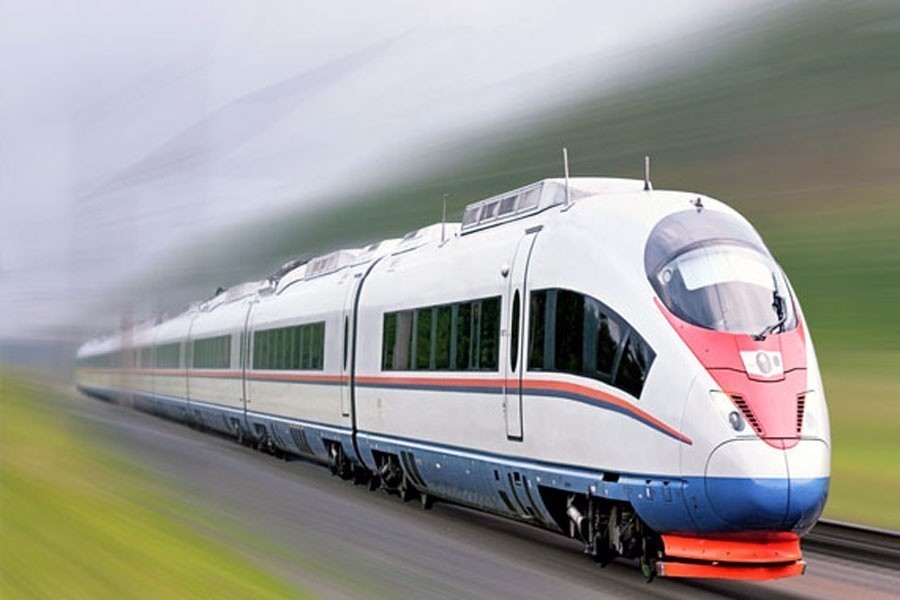Plans on the ambitious project of cutting down the travel time on Dhaka-Ctg rail route have been in circulation for nearly two decades. Governments one after another continued to propose their respective plans on drastically shortening the time required for the journey. A similar and more ambitious project for introducing a railway service has recently been announced. It coincided with the abandonment of an expressway connecting Dhaka with the port city. The government decision to drop the 10-year-long expressway project was announced at a meeting of the Cabinet Committee on Economic Affairs last week. Currently, the Prime Minister is in favour of building a high-speed railway.
As has been reported in some print media outlets, the government now is set to construct a 'service lane' alongside the existing 4-lane highway. Given the fast-growing traffic on the Dhaka-Chattogram Highway, the government in 2004 embarked on the grand initiative to build an 'access-controlled expressway'. Evidently, it followed the government resolve to alleviate the sufferings of people using the highway. As has been shown by official records, the traffic volume on the highway in 2009 was between 20,000 and 25,000 --- 40 per cent of which being heavy cargo-laden vehicles.
Turning to the past, the expressway project for construction under PPP model got its approval in March, 2013. Following it, a feasibility study was undertaken and a detailed design of the high-speed roadway prepared. A large sum of money has already been spent on the project. In a development, the government has now decided that instead of constructing the expressway, the existing 4-lane road will be expanded along with the construction of a separate service lane. In reports published in the local print media, the cabinet division additional secretary has said the government decided to expand the existing highway. His observation came upon queries from the media personnel as to why the government cancelled the project after spending Tk 1.0 billion for feasibility study and detailed designing. It's worth mentioning that the government had planned to build the 217-kilometre expressway at a cost of Tk 335 billion in order to facilitate trade through a dedicated road.
Meanwhile, a proposal for building a 224.64-kilometre high-speed rail route on the Dhaka-Narayanganj-Cumilla-Feni-Chattogram route has already been approved by the Prime Minister. The Prime Minister's approval of the high-speed rail project couldn't have come at a more suitable time. The Bangladesh Railway authorities, evidently, are in a race against time to complete the project's feasibility study and the detailed design work. The said Dhaka-Chattogram railway travel is set to take just 55-73 minutes.
The communication authorities of a past ruling government stunned the people highly dependent on Dhaka-Chattogram-Dhaka rail travels in the early 1990s. They said the travel time for connecting the two ends by railway would be reduced to just one hour. The time for this travel used to be 8 hours in the late 1960s. A couple of speedier inter-city trains introduced in the recent years take 6 to 7 hours on Dhaka-Chattogram journeys. The 8-hour journey time had been in place in the late Pakistan days, after the introduction of the nonstop Ulka on the vital rail route. Over the last one decade, or a little more, the nonstop inter-city trains have reduced the travel time further. The travels are operated by mainly Sonar Bangla Express, Suborna Express and TurnaNishitha. The thoughts are related to rail travels on high-speed trains, some being termed outright utopian, as they range from magnetically levitating trains to 'bullet trains' as found in Japan and China. While toying with the idea of introducing super-speed trains on the Dhaka-Chattogram route, few in the sector had hardly given a thought to the state-of-the-art infrastructure required for such trains.
As had been seen with a number of such grand projects in the past, the thoughts on the introduction of high-speed or super-speed passenger train services between the capital and the port city eventually petered away. Why wouldn't they? In spite of the literal storms of debate on the need for a double-track railway route or dual gauge lines, they have yet to materialise. Moreover, time-befitting signalling and other technical backings, mostly digitised, are a sine qua non. All these still remain elusive.
The topic of a high-speed railway service on Dhaka-Chattogram route has resurfaced lately after the government started mulling it in all seriousness. The railway project has been taken up after the government dropped a mega road communication infrastructural set-up which was underway.Maybe, experts have detected built-in weaknesses in the whole mechanism or its future operational efficiency. The now-abandoned Dhaka Chittagong Expressway mega project had witnessed the spending of an astronomical sum of money in spadework.If thought out pragmatically from the beginning, keeping in consideration the inherent strength of a high-speed railway service, both the common people and the country's trade and economy would have been benefited greatly.
It's relieving to some that the meeting of the Cabinet Committee on Economic Affairs approved the proposal of scrapping the expressway project. It was one of the few public-private partnership (PPP) projects pioneering the concept in Bangladesh. The expressway leviathan under the PPP model received the nod in March 2013. It was followed by a 'feasibility study' and the preparation of a 'detailed design', now deemed a sheer exercise in futility --- and waste of money.


